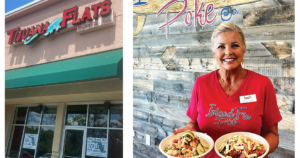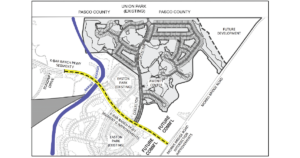To appreciate what local drivers endure every day and to fin d ways to fix our traffic problems, traffic engineer Jerry Wentzel had a computer-equipped car make more than 180 runs driving the speed limit through the Bruce B. Downs (BBD) Blvd. corridor in New Tampa collecting data.
d ways to fix our traffic problems, traffic engineer Jerry Wentzel had a computer-equipped car make more than 180 runs driving the speed limit through the Bruce B. Downs (BBD) Blvd. corridor in New Tampa collecting data.
And, perhaps, a few choice words by those frustrated that the car was driving the speed limit.
“If you did see the car, I hope you’re not the people that were giving us obscene gestures,” Wentzel joked. “A lot of drivers in your community don’t think 45 is the right speed limit.”
But, by the end of his presentation to roughly 50 people at Compton Park in Tampa Palms on July 25, the only gesture Wentzel — the Southeast Regional manager for DKS, a transportation planning and engineering firm that recently completed a traffic light study in New Tampa — received was a thumbs up.
Wentzel and Vik Bhide, the chief traffic management engineer for the City of Tampa, told an audience of New Tampa residents, as well as a handful of political hopefuls that not only are changes in the traffic light cycles speeding things up, plans for three additional turn-only signals will continue to ease congestion.
“You should be able to recognize there has already been an improvement,” said Wentzel.
The traffic light study was hatched to address a number of concerns, primarily helping move traffic through side streets like Cross Creek Blvd., Amberly Dr. and Tampa Palms Blvd. onto and off of BBD and facilitating a steady traffic flow during peak hours that would make the roads safer, not just for cars but for cyclists and pedestrians as well.
The lights are also now timed to favor busier traffic at certain times. For example, in the morning, the lights will favor southbound traffic, and in the evening, they will favor northbound traffic.
“In the past….BBD was one giant green (light),” Bhide said. “You were running four-and-a-half-minute cycles. If you were on Bruce B. Downs and got the first green light, you were great. If you were on a side street, you were waiting for a very long time. Our goal was to reduce the delay for everyone.”
Three corridors were studied for improvements in the weekday a.m., midday and p.m. hours, as well as Saturday morning and evening hours. The Saturday results were applied to Sunday, which was not specifically studied.
“In some cases, the signals were really way off,” said Wentzel. “The timings were changed dramatically.”
The four-mile stretch from I-75 to E. Bearss Ave., which has nine traffic signals, saw the largest improvements.
According to the study, by recalibrating the cycles of the signals from an average of 222 seconds (3:42) to 146 seconds (2:26), the average delay was reduced from 139 seconds (2:19) to 73 seconds, or 1:13.
The BBD widening project allowed weekday PM cycle lengths to be reduced from 254 seconds (4:14) to 130 (2:10).
“Because it’s now four lanes, it allowed us to reduce the cycle length and give more time to the side streets and cut the delay for coming off the side streets,” Wentzel said.
The changes also helped increase the average travel speed along BBD from 31.6 miles per hour to 37.6 mph, suggesting a smoother flow of traffic. The biggest increases were seen in the weekday midday hours (31.5 to 39 mph) and Saturday p.m. hours (32 to 43).
“That’s pretty dramatic,” Wentzel said. “People in that corridor should feel the changes, should be driving better, stopping less and spending a lot less time in traffic.”
Requiring minor tweaks in the cycle lengths was the corridor along Cross Creek Blvd. between BBD and Morris Bridge Rd. Improvements there helped reduce the average delay for drivers by 37 percent. Delays getting off the side streets were not as much of an issue, so the improvements focused on the east-west movement along Cross Creek Blvd.
“From one end to the other was 134 seconds (2:14), now down to 85 seconds (1:25),” Wentzel said. “That’s a pretty big reduction and something the average person should feel. We felt those were good results, very positive results.”
The third corridor studied, BBD from Cross Creek Blvd. to I-75, was the trickiest, Wentzel said.
While the signals clearly favored BBD traffic, it did not recognize that 40 percent of the traffic in the corridor was coming off Cross Creek Blvd. The result has been significantly longer cycle times for traffic turning south onto BBD from Cross Creek. That has slowed the average speed in that corridor by 1 percent and increased the average delay by 10 percent, numbers that Wentzel called insignificant.

“If you look at the study results, it didn’t really benefit BBD traffic, because the intention was to help Cross Creek,” he said.
While the study may produce small numbers measured in seconds and minutes, when you multiply that one car by days and then times per month, you get a bigger, brighter picture (see graphic above).
“The cumulative savings to the community are significant, and to the environment are significant” Bhide said.
Bhide also said the light signal changes also will benefit bicyclists and pedestrians, who tend to take risks crossing when they are stuck at long cycles favoring BBD.
Combined with the significant amount of time saved by motorists, as well as the environmental benefits, Bhide said this light study was a success.
“We don’t always see these kind of dramatic results from signal changes,” he said. “This just happened to be a pretty good story for us to tell.”
Right-Turn Signals To Be Added!
In addition to the recently completed traffic light changes, right-turn signals will be installed at northbound BBD and Cross Creek Blvd., as well as eastbound Highwoods Preserve Pkwy. and BBD (where p.m. traffic from the business campuses behind the AMC Highwoods movie theater complex can stretch on and on) over the next 80-90 days.

Both lanes are choke points during peak traffic hours in the evening, and the BBD/Cross Creek Blvd. location in particular has drawn the ire of many local residents.
“We’ve done what we can with signal timing, but the right turns could be going at the same time the lefts are going if we had a signal for it,” Wentzel said.
As for a third left turn lane off Cross Creek Blvd., Wentzel and Bhide both said that’s just a matter of time, and money. While Bhide works for the city, that intersection is a county asset that the city maintains, per an interlocal agreement.
“We have talked to the county about putting that as a project in their capital improvement plan, and tentatively, they are reviewing that and will try to get it funded in the next few years,” Bhide said.
The traffic signal study was hosted by the New Tampa Council (NTC). Along with District 7 Tampa City Council member Luis Viera, who founded the NTC, the crowd also included a handful of political candidates running for seats, either in the upcoming “mid-term” elections in August and November, or in March 2019, that will represent New Tampa — Angela Birdsong (running for Hillsborough County Commissioner District 2), Joseph Caetano and Joe Citro (Tampa City Council Dist. 1) and Fentrice Driskell, who is running against incumbent Shawn Harrison for the Florida House of Representatives Dist. 63 seat.




No comment yet, add your voice below!